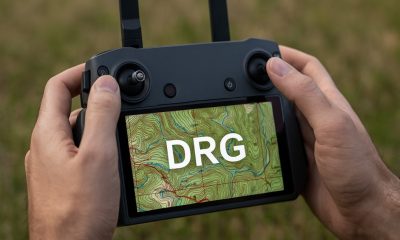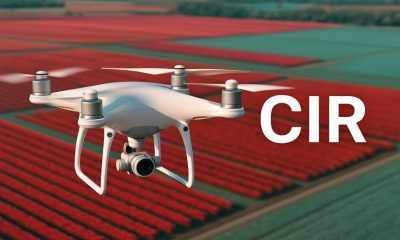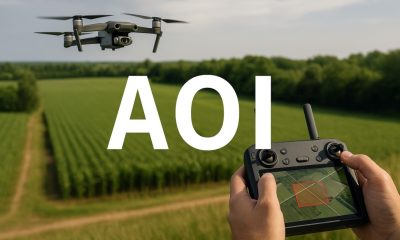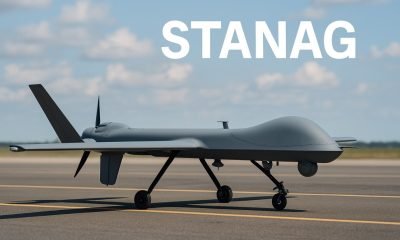- Acronym Guide
- AAM
- ABS
- AC
- ACAS
- ADS-B
- AFAC
- AGL
- AI
- AIM
- ALS
- AM
- AMA
- ANSP
- AOI
- APPI
- AUV
- AUVSI
- ARPAS-UK
- ASTM
- ATC
- BVLOS
- CAA
- CAAC
- CAB
- CASA
- CATT
- CBO
- CBR
- CBRN
- CDMA
- CDR
- CFR
- CIR
- COA
- COMINT
- CORS
- COTP
- COTR
- CPTED
- CV
- C2
- DAA
- DEM
- DFI
- DFS
- DGCA
- DHS
- DOD
- DPA
- DPEs
- DRG
- DRO
- DSM
- DSMX
- DSP
- DSSS
- DTM
- EASA
- EFT
- EO
- EOD
- EO/IR
- ELINT
- EMI
- ESC
- EVLOS
- eVTOLs
- FAA
- FCC
- FCS
- FHSS
- FICCI
- FLIR
- FOB
- FOV
- FPS
- FPV
- GBDAA
- GCP
- GCS
- GDPR
- GML
- GNSS
- GPS
- GSD
- GVC
- HDR
- HOGE
- IACRA
- ICAO
- ICS
- IMU
- INS
- IR
- ISA
- ISR
- ITU
- JARUS
- LAAMS
- LAANC
- LAATM
- LAI
- LBA
- LIDAR
- LOS
- LSALT
- MAC
- MAVLink
- MLIT
- MMS
- MSL
- MTOM
- NDAA
- NCSL
- NFZ
- NIST
- NMEA
- NOTAM
- NPA
- NPRM
- NTIA
- OBIA
- OEM
- OFDM
- OOP
- PASM
- PAV
- PCV
- PdM
- PEC
- PIC
- PID
- PIPL
- PLD
- PM
- PN
- PPK
- PPS
- PSM
- PWM
- UAM
- UAOP
- UAS
- UASTM
- UAV
- UCAVs
- UHD
- UHF
- USV
- UTM
- RAIM
- RCC
- RCS
- RFI
- ReOC
- RePL
- RMS
- ROI
- RPAS
- RPC
- RTH
- RTK
- SaR
- SAR
- SARP
- SBAS
- S.Bus
- SBIR
- SEDENA
- SfM
- SFOC
- SIGINT
- SLAM
- SMS
- SORA
- STANAG
- STTR
- sUAS
- TCAS
- TCCA
- TFR
- TIN
- TOF
- TP
- TPS
- TSA
- VHF
- VLOS
- VTOL
Drone Acronyms
What is NTIA?
By
Jacob StonerTable Of Contents

Definition
NTIA stands for National Telecommunications and Information Administration. It is an agency of the U.S. Department of Commerce that is responsible for advising the President on telecommunications and information policy issues. The NTIA manages the federal use of spectrum and coordinates efforts to ensure efficient and effective use of telecommunications resources.
Relevance to the Industry
NTIA’s work is crucial for the drone industry as it helps ensure that drones have access to the necessary spectrum for safe and effective operation. By managing spectrum allocation and promoting policies that support technological advancements, NTIA facilitates the growth and integration of drones into the national airspace system.
How Does the National Telecommunications and Information Administration (NTIA) Work?
The National Telecommunications and Information Administration (NTIA) is an agency within the U.S. Department of Commerce responsible for advising the President on telecommunications and information policy issues. NTIA plays a crucial role in managing federal use of spectrum, ensuring the efficient use of telecommunications resources, and advocating for policies that promote innovation and competition in the telecommunications industry. Here’s a detailed explanation of how the NTIA works:
1. Purpose and Importance
- Spectrum Management: NTIA manages the federal government’s use of the radio frequency spectrum, ensuring that spectrum resources are used efficiently and effectively.
- Policy Development: Advises the President and federal agencies on telecommunications and information policy issues, fostering innovation, competition, and economic growth.
- Public Safety and Security: Supports the development and implementation of telecommunications systems that enhance public safety and national security.
- Broadband and Digital Inclusion: Promotes policies and programs aimed at expanding broadband access and closing the digital divide.
2. Key Components of NTIA
- Office of Spectrum Management (OSM): Responsible for managing the federal government’s use of spectrum, including frequency allocation, coordination, and spectrum sharing initiatives.
- Office of Policy Analysis and Development (OPAD): Develops policies and conducts research on telecommunications and information technology issues, providing analysis and recommendations to the President and federal agencies.
- BroadbandUSA: An initiative focused on promoting broadband deployment and adoption, supporting community broadband planning, and providing technical assistance to local governments and organizations.
- Institute for Telecommunication Sciences (ITS): NTIA’s research and engineering laboratory, which conducts cutting-edge research and provides technical expertise on telecommunications and information technology.
3. How NTIA Works
- Spectrum Management:
- Frequency Allocation: NTIA allocates spectrum frequencies to federal agencies, ensuring that spectrum resources are used efficiently and that there is minimal interference between different users.
- Coordination and Sharing: Coordinates with the Federal Communications Commission (FCC) and other stakeholders to facilitate spectrum sharing between federal and non-federal users, promoting efficient spectrum use.
- Spectrum Monitoring: Monitors the use of spectrum to identify and resolve interference issues, ensuring the integrity and reliability of telecommunications systems.
- Policy Development and Advocacy:
- Research and Analysis: Conducts research and analysis on telecommunications and information policy issues, providing data-driven recommendations to the President and federal agencies.
- Interagency Coordination: Works with other federal agencies, state and local governments, industry stakeholders, and international organizations to develop and implement telecommunications policies.
- Public Engagement: Engages with the public, industry, and other stakeholders through public consultations, workshops, and forums to gather input and build consensus on policy issues.
- Broadband and Digital Inclusion:
- Broadband Mapping and Data Collection: Collects and analyzes data on broadband availability and adoption to identify gaps and target resources effectively.
- Technical Assistance: Provides technical assistance to communities, local governments, and organizations to support broadband planning and deployment efforts.
- Grant Programs: Administers grant programs to fund broadband infrastructure projects, promote digital literacy, and support initiatives aimed at closing the digital divide.
- Research and Technical Expertise:
- Technical Standards and Testing: Develops technical standards and conducts testing to support the development and deployment of advanced telecommunications technologies.
- Emerging Technologies: Conducts research on emerging telecommunications technologies, such as 5G, artificial intelligence, and cybersecurity, providing technical expertise and guidance to policymakers.
4. Applications and Use Cases
- Spectrum Management for Federal Agencies: NTIA allocates and manages spectrum for federal agencies, ensuring that critical government operations, such as defense, public safety, and scientific research, have reliable access to spectrum resources.
- Broadband Expansion: Supports initiatives aimed at expanding broadband access in underserved and rural areas, promoting digital inclusion and economic development.
- Public Safety Communications: Develops and supports telecommunications systems that enhance public safety and emergency response capabilities.
- Research and Development: Conducts research on advanced telecommunications technologies, contributing to the development of standards and best practices for the industry.
5. Advantages and Challenges
- Advantages:
- Efficient Spectrum Management: NTIA’s management of federal spectrum resources ensures that spectrum is used efficiently and that interference is minimized, supporting reliable telecommunications services.
- Policy Expertise: Provides expert advice and analysis on telecommunications policy issues, helping to shape policies that promote innovation, competition, and economic growth.
- Broadband Promotion: Supports efforts to expand broadband access and adoption, helping to bridge the digital divide and promote digital inclusion.
- Technical Leadership: Conducts cutting-edge research and provides technical expertise on emerging telecommunications technologies, supporting the development of advanced telecommunications systems.
- Challenges:
- Spectrum Demand: Balancing the growing demand for spectrum from various sectors, including commercial, government, and public safety users, is a complex challenge.
- Policy Coordination: Ensuring effective coordination and collaboration among multiple stakeholders, including federal agencies, state and local governments, industry, and international organizations.
- Funding and Resources: Securing sufficient funding and resources to support NTIA’s programs and initiatives, particularly in areas such as broadband deployment and digital inclusion.
- Technological Advancements: Keeping pace with rapid technological advancements in telecommunications and information technology, and ensuring that policies and regulations are adaptive and forward-looking.
6. Technological Advances
- 5G and Beyond: NTIA supports the development and deployment of 5G networks and explores future telecommunications technologies beyond 5G, such as 6G and next-generation wireless systems.
- Spectrum Sharing Technologies: Researches and promotes spectrum sharing technologies that enable more efficient use of spectrum resources, allowing multiple users to coexist in the same frequency bands.
- Cybersecurity: Conducts research on cybersecurity for telecommunications systems, developing best practices and standards to protect against cyber threats.
- Artificial Intelligence and Machine Learning: Explores the use of AI and machine learning in telecommunications, enhancing network management, spectrum monitoring, and interference mitigation.
Understanding how the National Telecommunications and Information Administration (NTIA) works highlights its critical role in managing the federal use of spectrum, developing telecommunications policies, and promoting broadband access and digital inclusion. Through its diverse functions and initiatives, NTIA ensures the efficient use of telecommunications resources, supports innovation and competition, and enhances the overall security and reliability of the nation’s telecommunications infrastructure.
Example in Use
“The NTIA collaborated with the FAA to allocate spectrum for UAS operations, ensuring reliable communication channels for drone pilots.”
Frequently Asked Questions about NTIA (National Telecommunications and Information Administration)
1. What is the role of the NTIA in drone operations?
Answer: The role of the NTIA in drone operations includes:
- Spectrum Management: Allocating and managing the spectrum required for reliable communication and data transmission for drones.
- Policy Development: Advising on and developing telecommunications policies that support the safe and efficient integration of drones into the national airspace.
- Coordination: Working with other federal agencies, such as the FAA, to ensure that spectrum resources are used effectively and that regulatory frameworks support drone innovation and safety.
2. How does NTIA support the growth of the drone industry?
Answer: NTIA supports the growth of the drone industry by:
- Ensuring Spectrum Availability: Providing the necessary spectrum for drone communication and control systems to operate effectively.
- Promoting Innovation: Developing policies that encourage technological advancements and the deployment of new drone applications.
- Facilitating Coordination: Coordinating with federal, state, and local agencies to create a cohesive regulatory environment that supports the integration of drones.
- Enhancing Connectivity: Supporting initiatives that improve broadband and communication infrastructure, which are essential for advanced drone operations.
3. What are some of the key initiatives of the NTIA related to drones?
Answer: Key initiatives of the NTIA related to drones include:
- Spectrum Allocation: Managing the allocation of spectrum to ensure that drones have access to reliable communication channels.
- Policy Guidance: Providing policy recommendations and guidance to support the safe and effective use of drones.
- Interagency Collaboration: Working with agencies like the FAA and FCC to address regulatory challenges and promote a unified approach to drone integration.
- Research and Development: Supporting research and development efforts to advance drone technology and address technical challenges related to telecommunications and information policy.
For examples of these acronyms visit our Industries page.
As the CEO of Flyeye.io, Jacob Stoner spearheads the company's operations with his extensive expertise in the drone industry. He is a licensed commercial drone operator in Canada, where he frequently conducts drone inspections. Jacob is a highly respected figure within his local drone community, where he indulges his passion for videography during his leisure time. Above all, Jacob's keen interest lies in the potential societal impact of drone technology advancements.











